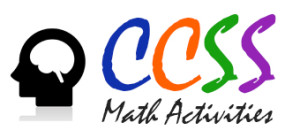Performance Task = Math Masterpiece
One of the components to the Smarter Balanced Assessment (SBA) is the performance task. Performance tasks allow students to engage in an extended problem solving situation. The rich task gives students an opportunity to show their mathematical and critical thinking knowledge and skills across different standards. Using all of these skills helps students on their path to college and career readiness. However, preparing students for this new component may seem overwhelming for some teachers.
The teachers at SMc Curriculum met at the beginning of the school year to determine how best to help teachers practice the performance task. We quickly found that doing a Google search for “performance tasks” would mostly either: 1) lead us to the practice tasks on the SBA website or; 2) lead us to really problem-solving tasks but not performance tasks when comparing to Smarter Balanced item specifications for a performance task. A good performance task that will allow students to practice the skills required by the Smarter Balanced Assessment must have questions that reach up to a Depth of Knowledge Level 4. Unfortunately, a majority of the resources we found online did not quite reach that far. So, we adapted! We took the tasks that were really good and appropriate for the grade level and extended the questions to include DOK levels 3 and 4 if they did not already exist. You can see our final products under the Performance Task tab.
Once you have a good performance task, then what? How can you instruct students in the skills of perseverance and attention to precision that is necessary for success on a performance task? One idea is to create a Math Masterpiece.
Supplies needed per partner or group:
- a piece of construction paper (11 x 17 is preferable);
- a glue stick;
- a performance task cut into strips so that there are only 1 – 2 questions per strip.
How to run the activity:
- Students work in pairs on their first strip and bring it up to the teacher to get checked once they think they have completed the questions accurately. Consider asking students to have the writer on each strip rotate between the partners to ensure participation by all.
- The teacher will put a tick mark in the corner of the strip to indicate the partners have come up to get the task strip checked. If the answer is correct and the work sufficient, the tick mark is circled and the partners are given back that strip of paper along with the next strip of the performance task. If the answer is incorrect or the work is insufficient, the strip is handed back and a hint is given.
- Each time the teacher sees a strip, a new tick mark is added and scaffolded hints are given. The tick marks help you as a teacher keep track of how students are doing on each part of the task.
- Strips of paper with tick marks circled are glued onto the construction paper to begin their Math Masterpiece. This process continues until all partner sets have all the strips of paper glued onto their construction paper.
A Math Masterpiece gives students the chance to practice skills they need for the performance task. By keeping their strips of paper and gluing them onto the construction paper students are able to see how their answers from the first part of a problem solving task will affect the rest of the problem. For teachers, once the Masterpieces are complete and hung around the room or collected, you will be able to look at the strips of paper to see trends. Did most of your students get only one tick mark circled on the first strip? That most likely means that students understand the content from that question. But what if the fourth strip took almost every groups 2 or 3 times of trying (indicated by the tick marks) before they got the correct answer? Perhaps the skill practiced by that part of the task could stand to be retaught in class the next day. By working together and breaking the larger performance task into smaller, more manageable pieces students tend to more easily persevere through the large task.
Hopefully the different performance tasks we have collected will prove helpful in your classroom. What other ways have you been able to help prepare students for the performance task?
